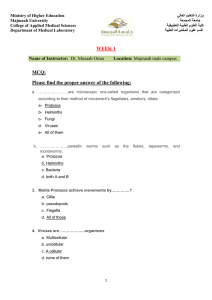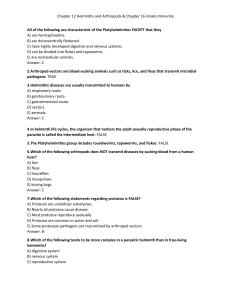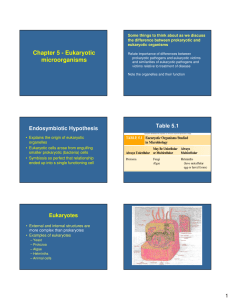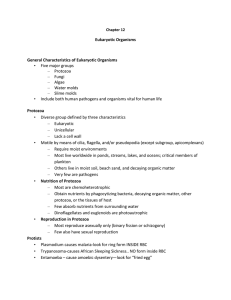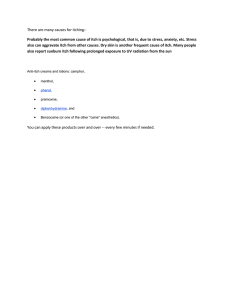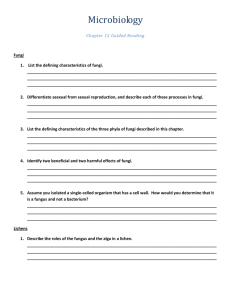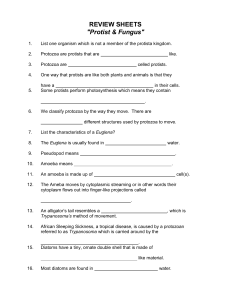The Eukaryotic Members of the Microbial World Algae
advertisement
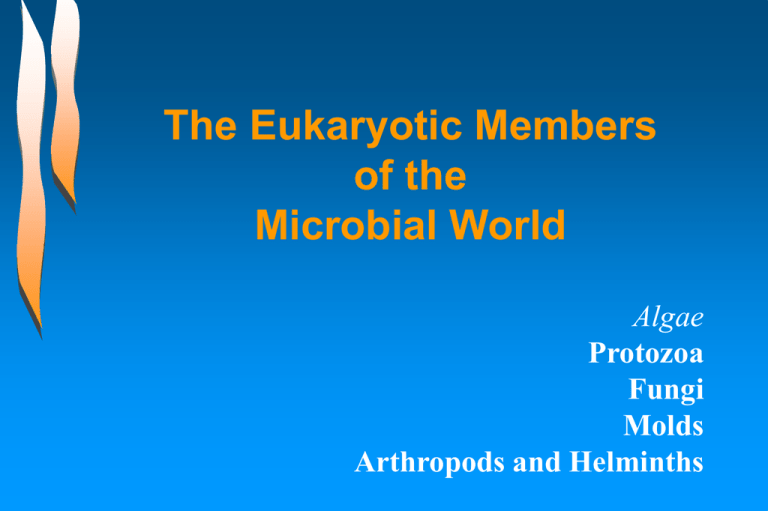
The Eukaryotic Members of the Microbial World Algae Protozoa Fungi Molds Arthropods and Helminths Algae • Eukaryotic cell structure • Microscopic and macroscopic sizes • Cell walls • Part of a group of organisms called phytoplankton (primary producers in the oceans) Algal Toxicity Red tides caused by • G. breve now K. brevis (Karenia brevis ): Brevetoxin kills fish feeding on phytoplankton and causes illness in ho and animals. (Famous Florida red tides). • Gonyaulax: neurotoxins that accumulates in shellfish (immune to it) cause paralytic shellfish poisoning in ho and animals. Death possible. Protozoa • Protozoan habitats – Mostly free – living, some parasitic – In marine (zooplankton) , fresh water and terrestrial environments • Structure of protozoa – Microscopic, unicellular, no chlorophyll – No cellulose cell wall (instead silicon, Ca etc.) – Cilia, flagella, pseudopodia grouped acc. to mode of locomotion Protozoan Reproduction • Sometimes complex life cycles • Protozoa can – be polymorphic – have vegetative (feeding) form = trophozoite or – resting form = cyst • Sexual or asexual reproduction Protozoa and Human Disease • Malaria (Plasmodium species) • African sleeping sickness (Trypanosoma brucei) • Toxoplasmosis (Toxoplasma gondii) • Vaginitis (Trichomonas vaginalis) Fungi are omnipresent Fungi Structure of fungi (yeasts, molds and mushrooms) Only few fungi cause disease in animals (mostly in immunocompromised individuals) Economic importance – – – – wine, beer, bread, and cheese production Antimicrobial medicines Biotechnology Many plant pathogens Fungal Disease in Humans Four types of fungal diseases 1. Allergies 2. Toxicities 3. Mycoses 4. Starvation due to food destruction Examples of fungal diseases • Candida albicans (candidiasis) • Cryptococcal meningoencephalitis • Histoplasma capsulatum (Histoplasmosis) • Pneumocystis carinii Multicellular Parasites • Arthropods and helminths medically important • Arthropods do (most) damage as vetctors • Helminths cause direct damage to host Arthropods • Arthropod borne diseases - Mechanical vectors (flies etc.) vs. biological vectors • Insects: Mosquitoes, fleas and lice • Arachnids: Ticks and mites (mites cause direct disease, e.g.: scabies) • Example diseases – Yellow fever – Mosquito - Flavivirus – Rocky mountain spotted fever – tick – Rickettsia – Other “famous” examples? Helminths Three groups of helminths relevant to medicine 1. Nematodes (roundworms): GI tract or blood infections 2. Cestodes (tapeworms) 3. Trematodes (flukes) Three modes of human invasion: - Skin penetration - Contaminated food - Insect vector Under control in developed countries, millions of deaths / year in underdeveloped countries Helminth Diseases • Enterobiasis (Nematode - Enterobius vermicularis) • Filariasis (Nematode - Wuchereria bancrofti) • Tapeworm disease (Tania solium) • Swimmer’s itch (Trematode - Cercaria sp.) Enterobiasis One of the most common parasitic infections of humans. Causative agent: Pinworm (Enterobius vermicularis) 10% to 40% of children (below age 12) are infected. Adult pinworms are white and are less than one half inch long, with the diameter of a strand of thread. The adult worms live in the colons of human children and feed on human fecal matter. Approximately 120 million people are infected. 90% are caused by Wuchereria bancrofti. Almost 25 million men suffer from genital disease (most commonly hydrocoele); an estimated 15 million people have lymphoedema or elephantiasis of the leg. e f o r s e v e r a l y e a r s , p r o d In their adult stage, filarial parasites live in the lymph vessels u The worms live for several years, producing millions of very c small, immature larvae, microfilariae,i that circulate in the n peripheral blood with marked nocturnal periodicity. Swimmer’s Itch - Cercarial Dermatitis The schistosome cercaria (originating in specific snail species) accidentally enters human skin. Swimmer’s itch cases have been reported from nearly every state. (Most predominant in the north). In addition, swimmer's itch has been reported from more than 30 countries. Disappears without treatment (after up to 7 days)
